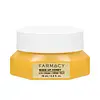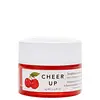What's inside
What's inside
 Key Ingredients
Key Ingredients

 Benefits
Benefits

 Concerns
Concerns

 Ingredients Side-by-side
Ingredients Side-by-side

Water
Skin ConditioningGlycerin
HumectantCoco-Caprylate/Caprate
EmollientPentaerythrityl Tetraisostearate
EmollientDiisostearyl Malate
EmollientButyrospermum Parkii Butter
Skin ConditioningCetearyl Alcohol
EmollientTetrahexyldecyl Ascorbate
AntioxidantCetearyl Olivate
Pentylene Glycol
Skin ConditioningHelianthus Annuus Seed Oil Unsaponifiables
EmollientSorbitan Olivate
EmulsifyingBoron Nitride
AbsorbentCaffeine
Skin ConditioningHyaluronic Acid
HumectantCeramide NP
Skin ConditioningVaccinium Macrocarpon Fruit Extract
AstringentCoffea Arabica Seed Extract
MaskingHoney Extract
HumectantPropolis Extract
Skin ConditioningRoyal Jelly Extract
Skin ConditioningCitrus Aurantium Amara Fruit Extract
Skin ConditioningCitrus Aurantium Sinensis Peel Extract
Skin ConditioningCitrus Reticulata Fruit Extract
Skin ProtectingAscorbic Acid
AntioxidantTridecapeptide-1
Skin ConditioningBetaine
HumectantTriolein
Skin ConditioningHydroxyacetophenone
AntioxidantTocopheryl Acetate
AntioxidantAstaxanthin
Skin ConditioningAllantoin
Skin ConditioningHippophae Rhamnoides Oil
EmollientTocopherol
AntioxidantUbiquinone
AntioxidantLecithin
EmollientHaematococcus Pluvialis Extract
AntioxidantGlyceryl Dioleate
EmollientWater, Glycerin, Coco-Caprylate/Caprate, Pentaerythrityl Tetraisostearate, Diisostearyl Malate, Butyrospermum Parkii Butter, Cetearyl Alcohol, Tetrahexyldecyl Ascorbate, Cetearyl Olivate, Pentylene Glycol, Helianthus Annuus Seed Oil Unsaponifiables, Sorbitan Olivate, Boron Nitride, Caffeine, Hyaluronic Acid, Ceramide NP, Vaccinium Macrocarpon Fruit Extract, Coffea Arabica Seed Extract, Honey Extract, Propolis Extract, Royal Jelly Extract, Citrus Aurantium Amara Fruit Extract, Citrus Aurantium Sinensis Peel Extract, Citrus Reticulata Fruit Extract, Ascorbic Acid, Tridecapeptide-1, Betaine, Triolein, Hydroxyacetophenone, Tocopheryl Acetate, Astaxanthin, Allantoin, Hippophae Rhamnoides Oil, Tocopherol, Ubiquinone, Lecithin, Haematococcus Pluvialis Extract, Glyceryl Dioleate
Water
Skin ConditioningDiisostearyl Malate
EmollientPentaerythrityl Tetraisostearate
EmollientPentylene Glycol
Skin ConditioningAscorbyl Tetraisopalmitate
AntioxidantOrbignya Oleifera Seed Oil
EmollientPhytosterols
Skin ConditioningCaprylic/Capric Triglyceride
Masking3-Glyceryl Ascorbate
AntioxidantGlycerin
HumectantAcrylates/C10-30 Alkyl Acrylate Crosspolymer
Emulsion StabilisingMalpighia Punicifolia Fruit Extract
AntioxidantCaffeine
Skin ConditioningSodium Hyaluronate
HumectantHydrolyzed Sodium Hyaluronate
Skin ConditioningSodium Acetylated Hyaluronate
HumectantSodium Hyaluronate Crosspolymer
HumectantHydrolyzed Plukenetia Volubilis Seed Extract
Emulsion StabilisingLinoleic Acid
CleansingPhospholipids
Skin ConditioningBisabolol
MaskingHelianthus Annuus Extract
EmollientPhysalis Angulata Extract
Skin ProtectingBis-Diglyceryl Polyacyladipate-1
EmollientOryza Sativa Bran Extract
Skin ConditioningTocopherol
AntioxidantHexamidine Diisethionate
EmollientSodium Phytate
Melia Azadirachta Extract
Skin ConditioningMoringa Oleifera Seed Oil
EmollientEthylhexylglycerin
Skin ConditioningPotassium Hydroxide
BufferingRosmarinus Officinalis Leaf Extract
AntimicrobialButylene Glycol
HumectantCitric Acid
BufferingSodium Benzoate
MaskingWater, Diisostearyl Malate, Pentaerythrityl Tetraisostearate, Pentylene Glycol, Ascorbyl Tetraisopalmitate, Orbignya Oleifera Seed Oil, Phytosterols, Caprylic/Capric Triglyceride, 3-Glyceryl Ascorbate, Glycerin, Acrylates/C10-30 Alkyl Acrylate Crosspolymer, Malpighia Punicifolia Fruit Extract, Caffeine, Sodium Hyaluronate, Hydrolyzed Sodium Hyaluronate, Sodium Acetylated Hyaluronate, Sodium Hyaluronate Crosspolymer, Hydrolyzed Plukenetia Volubilis Seed Extract, Linoleic Acid, Phospholipids, Bisabolol, Helianthus Annuus Extract, Physalis Angulata Extract, Bis-Diglyceryl Polyacyladipate-1, Oryza Sativa Bran Extract, Tocopherol, Hexamidine Diisethionate, Sodium Phytate, Melia Azadirachta Extract, Moringa Oleifera Seed Oil, Ethylhexylglycerin, Potassium Hydroxide, Rosmarinus Officinalis Leaf Extract, Butylene Glycol, Citric Acid, Sodium Benzoate
 Reviews
Reviews

Ingredients Explained
These ingredients are found in both products.
Ingredients higher up in an ingredient list are typically present in a larger amount.
Caffeine is most associated with coffee, tea, and cacao. In skincare, it helps with calming inflammation and is rich in antioxidants.
While caffeine is used to treat cellulite and and dark circles, further studies are needed to prove this. It has been believed to help with these skin conditions due to its ability to dilate blood vessels and increase blood flow.
Some studies are looking into caffeine's ability to protect against UV rays.
Learn more about CaffeineDiisostearyl Malate is an emollient and most often used in lip products. It comes from isostearyl alcohol, a fatty acid, and malic acid, an AHA.
As an emollient, Diisostearyl Malate helps create a thin film on your skin to trap moisture in. This helps keep your skin soft and smooth.
Glycerin is already naturally found in your skin. It helps moisturize and protect your skin.
A study from 2016 found glycerin to be more effective as a humectant than AHAs and hyaluronic acid.
As a humectant, it helps the skin stay hydrated by pulling moisture to your skin. The low molecular weight of glycerin allows it to pull moisture into the deeper layers of your skin.
Hydrated skin improves your skin barrier; Your skin barrier helps protect against irritants and bacteria.
Glycerin has also been found to have antimicrobial and antiviral properties. Due to these properties, glycerin is often used in wound and burn treatments.
In cosmetics, glycerin is usually derived from plants such as soybean or palm. However, it can also be sourced from animals, such as tallow or animal fat.
This ingredient is organic, colorless, odorless, and non-toxic.
Glycerin is the name for this ingredient in American English. British English uses Glycerol/Glycerine.
Learn more about GlycerinPentaerythrityl Tetraisostearate is derived from isostearic acid. It is an emollient and emulsifier.
The highest concentration of this ingredient is found in lipsticks.
This ingredient is minimally water soluble and may not be Malassezia folliculitis, or fungal-acne safe.
Learn more about Pentaerythrityl TetraisostearatePentylene glycol is typically used within a product to thicken it. It also adds a smooth, soft, and moisturizing feel to the product. It is naturally found in plants such as sugar beets.
The hydrophilic trait of Pentylene Glycol makes it a humectant. As a humectant, Pentylene Glycol helps draw moisture from the air to your skin. This can help keep your skin hydrated.
This property also makes Pentylene Glycol a great texture enhancer. It can also help thicken or stabilize a product.
Pentylene Glycol also acts as a mild preservative and helps to keep a product microbe-free.
Some people may experience mild eye and skin irritation from Pentylene Glycol. We always recommend speaking with a professional about using this ingredient in your routine.
Pentylene Glycol has a low molecular weight and is part of the 1,2-glycol family.
Learn more about Pentylene GlycolTocopherol (also known as Vitamin E) is a common antioxidant used to help protect the skin from free-radicals and strengthen the skin barrier. It's also fat soluble - this means our skin is great at absorbing it.
Vitamin E also helps keep your natural skin lipids healthy. Your lipid skin barrier naturally consists of lipids, ceramides, and fatty acids. Vitamin E offers extra protection for your skin’s lipid barrier, keeping your skin healthy and nourished.
Another benefit is a bit of UV protection. Vitamin E helps reduce the damage caused by UVB rays. (It should not replace your sunscreen). Combining it with Vitamin C can decrease sunburned cells and hyperpigmentation after UV exposure.
You might have noticed Vitamin E + C often paired together. This is because it is great at stabilizing Vitamin C. Using the two together helps increase the effectiveness of both ingredients.
There are often claims that Vitamin E can reduce/prevent scarring, but these claims haven't been confirmed by scientific research.
Learn more about TocopherolWater. It's the most common cosmetic ingredient of all. You'll usually see it at the top of ingredient lists, meaning that it makes up the largest part of the product.
So why is it so popular? Water most often acts as a solvent - this means that it helps dissolve other ingredients into the formulation.
You'll also recognize water as that liquid we all need to stay alive. If you see this, drink a glass of water. Stay hydrated!
Learn more about Water